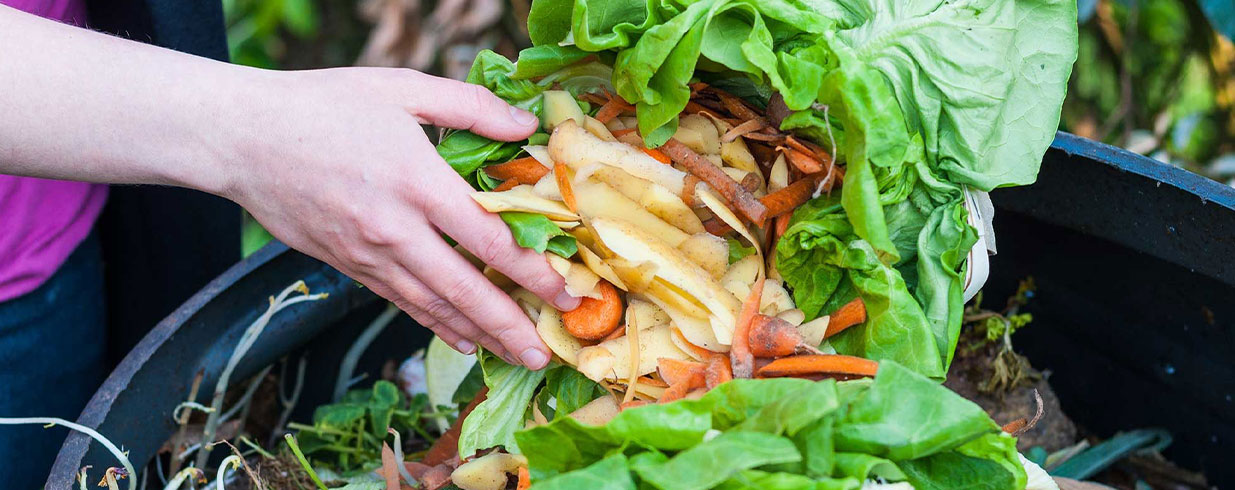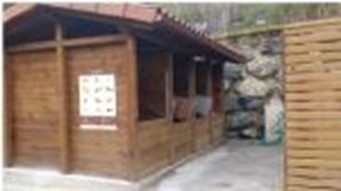The small town of Leinz-Gatzaga, Spain, developed a community composting system to manage all the generated biowaste.

Community composting to manage 100% of biowaste in a rural area of Spain
EXPECTED OBJECTIVES
The objective is to locally manage biowaste (that represented 25% of residual waste when the project started) at limited cost.
BACKGROUND INFORMATION AND LOCATION
General information on waste management:
• Biowaste generation: 80 kg/inh/yr
• Biowaste managed on-site: 75 kg/inh/yr
• Share of biowaste managed by the system: 90%
General information on the territory:
• Location: Leintz Gatzaga
• Country: Spain
• Population of the urban area: 232
• Density: 16 inh./km²
70% of the population resides in a small urban area with high-rise housing, and the rest is scattered in 35 hamlets located in the vicinity.
General information on the composting strategy:
• Number of composting units: 1
• Number of composting cells: 8
• Volume of the site: 10 m³
• Number of operators: 1, 4 hours of work per week
• Users: 215 inhabitants, 4 large biowaste generators (restaurants)
• Quantities managed: 2.4 t per month
IMPLEMENTING BODIES
The system was implemented by the Leintz-Gatzaga city council.
KEY STAKEHOLDERS INVOLVED
The main stakeholders are the inhabitants, bringing their waste to the composting unit.
GENERAL CONTEXT
This experience is part of a more general zero waste strategy that has been developed since 2009 in the Province of Gipuzkoa, Spain. In 2002, about 80% of waste was still landfilled in the province, and an incineration plant was supposed to be built Yet several municipalities started to implement zero-waste strategies as an alternative, focusing on biowaste recycling. A new regional waste management plan was presented in 2012, with a special focus on biowaste management and the proximity principle.
Decentralised composting, including home composting and community composting, was promoted in small villages and remote areas, as a solution to reduce the cost of collection and treatment.
DESCRIPTION OF THE ACTIVITIES
The system was progressively implemented in 2013-2014, along with selective collection of paper and packaging waste. Before this, all waste was collected together. Inhabitants living in the remote parts of the city were invited to start composting biowaste at home, allowing them to benefit from a 25% reduction of their waste tax after registration at the city hall. For the other inhabitants that could not do it, a community composting site was implemented in the centre of the town. Information sessions and direct communication activities were implemented to introduce the new system and collect suggestions from the population (such as the implementation of a water tap to clean the individual waste bins when bringing biowaste). Meetings were also organised with the local restaurants.
The system consists of a single composting site, composed of 8 composting units, representing about 10 m³ in total. The site is operated by a single person (a municipal employee), that performs daily controls and removal of impurities every morning, and aerates the compost once a week.
Inhabitants and large producers (restaurants) directly bring their biowaste (mostly food and kitchen waste) to the composting unit. Most participants live in the urban centre of the town, while the inhabitants living in the hamlets, generally perform home-composting. The composting area is centrally located, and people have to walk maximum 200 metres to reach it. Bring banks for other waste fractions are located close to the composting unit as well.
Each year, the unit produces about 7 tonnes of compost out of the 30 tonnes of biowaste treated. The produced compost, that presents a good quality, is used by the city council in public areas.
Newcomers generally adopt a proactive approach of composting, as a way to join the local community.
Regular communication activities are organised around the composting site, for instance during the “Week of the Environment”, where inhabitants are invited to harvest and check the produced compost, and discuss about the composting unit to identify possible improvement. Education actions targeting children are also organised.
FINANCING AND COST RECOVERY CONTEXT
The system is financed by the local council.
Investment costs are assessed at 175 €/household, with about 150 € for the materials and implementation, and about 20€ for training the participants and the operator, and setting the monitoring scheme.
Running costs are assessed at 16 €/household, with one third for maintenance, 15% for monitoring, and the rest for administration and materials. It represents about 56 €/t of biowaste treated, and about 3,200 € saved every year (compared to residual waste management).
MAIN ACHIEVEMENTS AND RESULTS
The community composting system manages almost all the biowaste generated in the urban area of the town, where more than 90% of the generated biowaste is recovered. It represents about 75 kg/inh./yr that is withdrawn from residual waste collection and treatment. It is assessed that about 80% of the population is participating in the action. This led to a sharp increase of the total recycling rate, that went from 20% in 2011 to 70% in 2015.
User satisfaction is quite high, with more than 85% of the participants being satisfied.
The advantage of community composting compared to home composting is the monitoring and coordination of the composting process, which guarantee the right sanitisation and quality of the produced compost.
Such a system also allows the creation of local jobs for monitoring and managing the composting unit.
KEY FACTORS OF SUCCESS
Participation is mostly due to the proactive attitude of the inhabitants. More than half of the participants declare that their participation is due to environmental concern, while 17% do it for complying to the system, and 13% because it is convenient.
The convenience of the system can be highlighted, as people can decide when and at what frequency they can dispose of their biowaste. Most people bring it once to twice a week.
A local management system also makes waste management more practical to inhabitants, as they can have a direct contact with the process and the outcomes.
In general, the key factors of success of a community composting system are:
• The involvement of the local population through a participative and transparent process;
• The design of the composting site: selection of a proper location (accessibility, convenience) and the dimensioning of the unit;
• The technical aspects, including the type of composting unit, and the availability of “bulking material” (garden waste that might need to be shredded);
• The training of the operator;
• The monitoring, maintenance, and quality of the compost.
Education and training are key elements, as the participants must know what to do, and why they have to do it. It is recommended to directly engage with the participants so that interactions are possible and suggestions can be collected. It is also important to ensure that the communication targets all the inhabitants, and not only the ones that are interested in environmental topics. Door-to-door campaigns and participative workshops can be recommended.
BOTTLENECKS, LIMITATIONS AND CHALLENGES
From the inhabitants that do not participate, the following reasons are given:
• 36% of the non-participants declare that it requires too much effort;
• 29% indicated the lack of space for putting bins in their housing units;
• 15% declared not separating any waste.
LESSONS LEARNED AND REPLICABILITY
The system is very suitable for small and remote areas, since it significantly reduces collection and transport costs compared to a centralised system. This also leads to saving, compared to residual waste management. The investment and running costs are quite small compared to a large-scale unit. It is also quicker to implement.
It heavily relies on the involvement of the local population, so much effort must be made to inform and train people, to make sure that they avoid impurities and comply with the guidelines.
Technical expertise is also important for the design and implementation, for the choice of container, the location, and the use of bulking materials to ensure the proper composition and aeration of the compost. These technical choices heavily depend on the local conditions, and it is not necessarily possible to replicate any other community composting system.
REFERENCES, LINKS TO FURTHER INFORMATION
• Zero Waste Europe (2019), Community Composting: A Practical Guide for Local Management of Biowaste, https://zerowasteeurope.eu/wp-content/uploads/2019/04/zero_waste_europe_fertile_auro_guide_community-composting_en-1.pdf
• Zero Waste Europe (2018), the Story of Gipuzkoa, https://zerowastecities.eu/bestpractice/best-practice-the-story-of-gipuzkoa/
• Ramon Plana (2020), Decentralised management of organic waste, presentation given during a “Zero Waste Live” on 17/03/2020, https://zerowastecities.eu/wp-content/uploads/2020/03/2020_03_17_webinar_01_plana.pdf
• Ramon Plana (2018), Community compostinng in rural areas – as exclusive model of biowaste management, Case 1: Leinz-Gatzaga (Basque Country, Spain), presentation given during ACR+ webinar on “Possibilities of decentralised bio-waste management through local composting” on 18/01/2018
• Ramon Plana (2018), Introduction to the different models for local composting, presentation given during ACR+ webinar on “Possibilities of decentralised bio-waste management through local composting” on 18/01/2018
• Elortza O. (2013), Aratusteen ostean izango dira auzo-konpostako bilerak, accessed on 10/09/2021, https://goiena.eus/gatzaga/1386609334475-aratusteen-ostean-izango-dira-auzo-konpostako-bilerak
• Madera U. (2016), Leintz Gatzagako aparkalekuan izandako luizia konponduta, erabilgarri dago gunea, accessed on 10/09/2021, https://goiena.eus/gatzaga/1461771541039-leintz-gatzagako-aparkalekuan-izandako-luizia-konponduta-erabilgarri-dago-gunea
• Iriondo J. (2013), Herrian konposta egiteko gune bi eta auzoetan hondakinak gaika batzeko edukiontziak jarriko dituzte Gatzagan, accessed on 10/09/2021, https://goiena.eus/gatzaga/1386609345905-herrian-konposta-egiteko-gune-bi-eta-auzoetan-hondakinak-gaika-batzeko-edukiontziak-jarriko-dituzte-gatzagan
• Unamuno I. (2016), Gatzagari buruzko txosten soziologikoa aurkeztu dute Gijongo kongresu batean, accessed on 10/09/2021, https://goiena.eus/gatzaga/1469188261186-gatzagari-buruzko-txosten-soziologikoa-aurkeztu-dute-gijongo-kongresu-batean
• Unamuno I. (2017), Ingurumen Astearen barruan ekintza ugari prestatu dituzte Gatzagan, accessed on 10/09/2021, https://goiena.eus/gatzaga/1494422204185-ingurumen-astearen-barruan-ekintza-ugari-prestatu-dituzte-gatzagan
Key information
Topic: recycling
Waste fraction: biowaste
Target group: households, farms
Instruments: infrastructure
Date of the implementation
Since 2013

